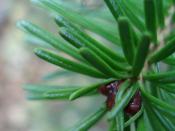To investigate whether there is a difference in the frequency of stomata between green and white areas of leaves
Plan
Prediction
I predict that there will be a higher stomatal frequency present in the green areas of the leaves as the green colour indicates the presence of chloroplasts containing chlorophyll, which are essential for the process of photosynthesis. In contrast, the white areas of the same species of plant do not contain chlorophyll, so it is evident that they do not take part in the photosynthesis, and therefore do not have a great need for gaseous exchange, so there is a lower stomatal frequency.
I think that the frequency of stomata will also differ in different species of plant. For example, xerophytic plants such as cacti, that are adapted to living in very dry conditions, will have a lower stomatal frequency. This is mainly due to their immense need to conserve water and reduce water loss through transpiration, which involves water evaporating out of the stomata.
Mesophytes, however, live in wetter conditions, and are not at risk when they transpire. Losing water through transpiration allows the movement of water up the xylem through cohesion. They have more stomata for gas exchange and losing water through transpiration does not pose too much of a threat as they do not need to conserve water.
Plants
The following plants will be used in the experiment:
Geranium is a plant which can be found growing in Britain. It grows well in warm, sunny conditions but can cope when exposed to colder conditions.
Chlorophtyum or spider plant is adapted to living in dry conditions. However, it can be found in many homes as a potted plant.
Hedra or ivy is adapted to living in moderate to warm conditions and prefers a humid environment.
Elaeagnus can...


